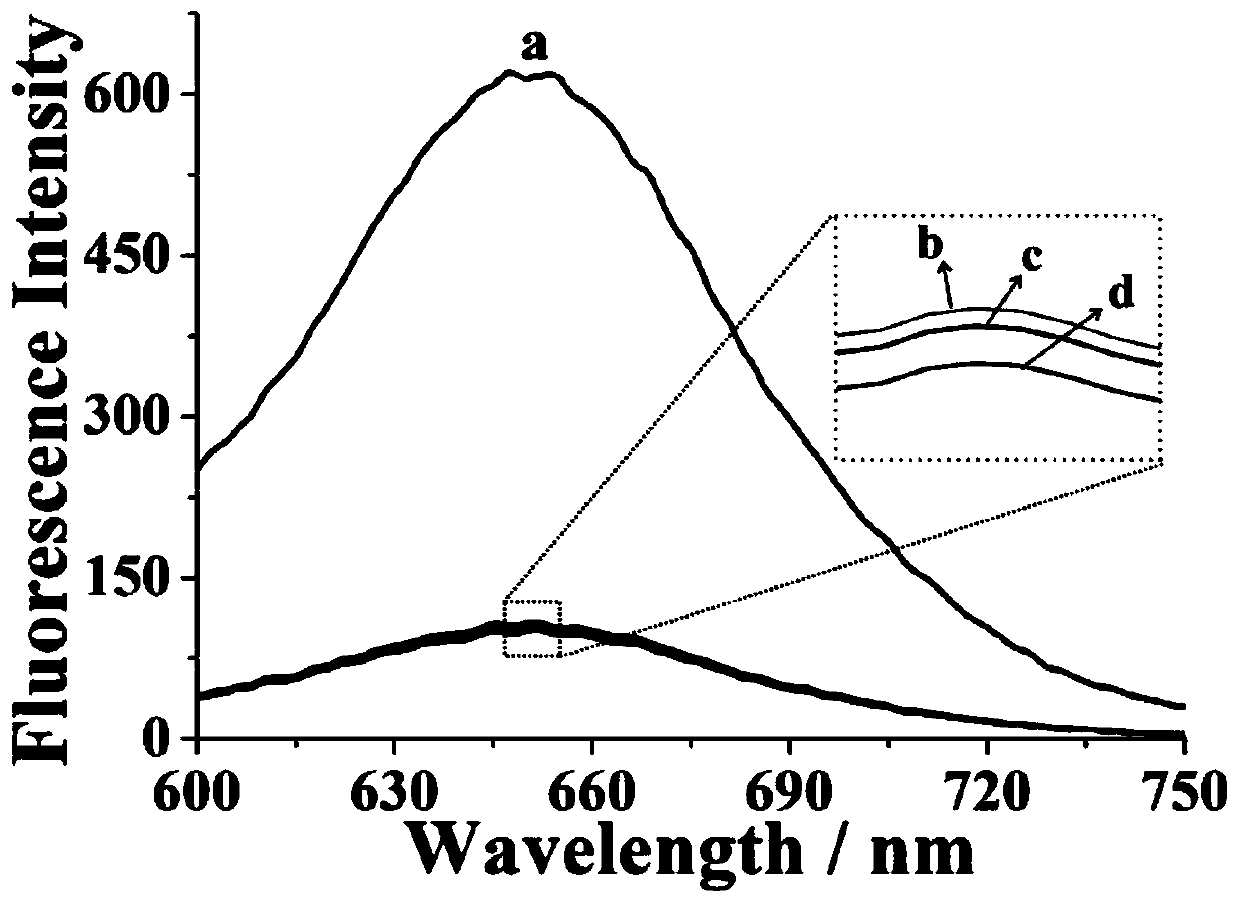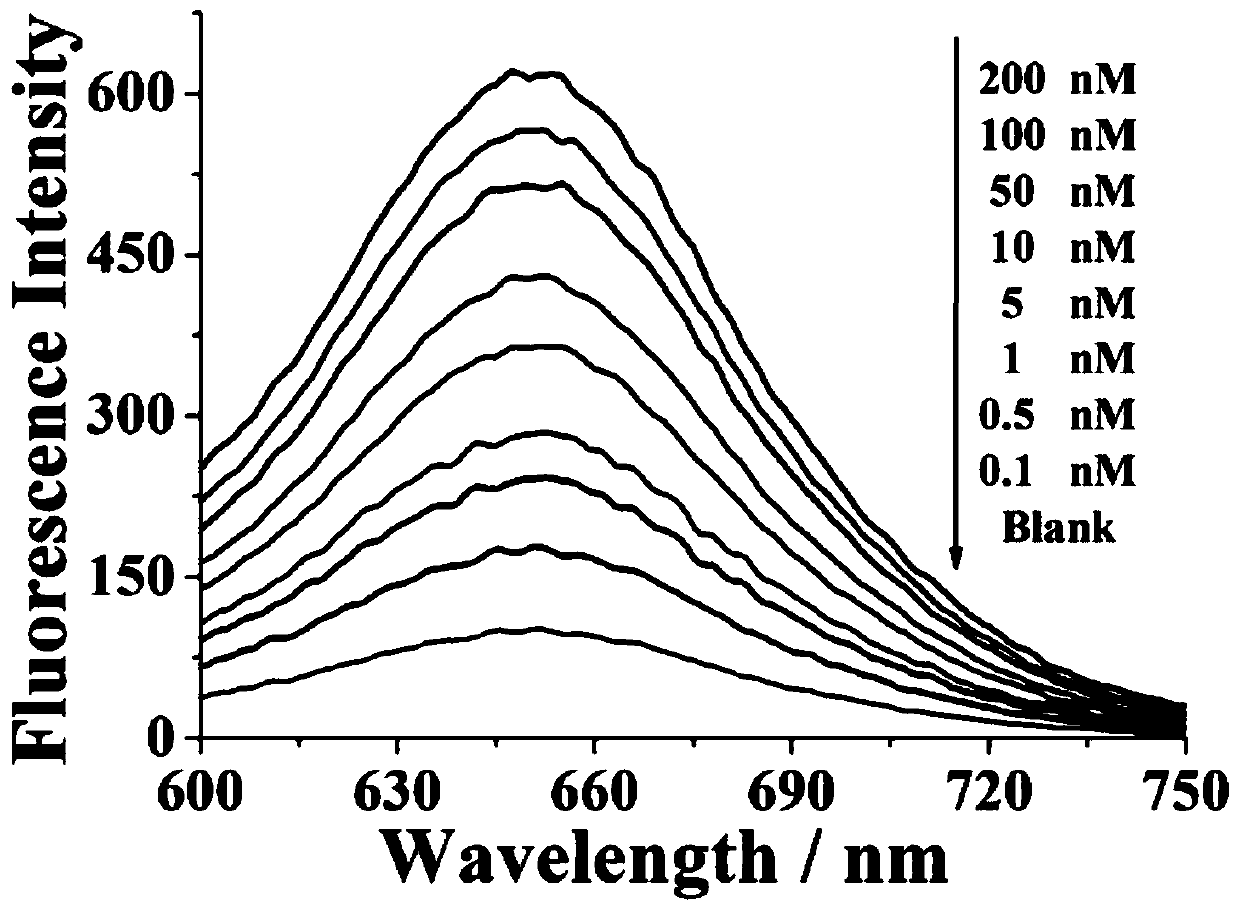Fluorescence biosensor based on light-up silver cluster probe and application thereof in miR-122 detection
A biosensor and probe technology, applied in the field of biosensors, can solve the problems of signal instability, complicated operation, poor reproducibility, etc., and achieve the effects of rapid response, low process cost and stable performance
- Summary
- Abstract
- Description
- Claims
- Application Information
AI Technical Summary
Problems solved by technology
Method used
Image
Examples
preparation example Construction
[0046] The preparation method of described biosensor comprises the following steps:
[0047] (1) Preparation of silver nanoclusters;
[0048] (2) The AgNC-SP / GrHP hybrid structure was formed by strand displacement reaction between the silver nanoclusters and the three-way structure in the homogeneous phase;
[0049] In the described preparation method, the preparation of silver nano clusters:
[0050] Silver nanoclusters were prepared according to the sodium borohydride reduction method reported in the literature. A mixed solution of DNA template strand AgNC-SP (15 μL, 100 μM) and silver nitrate (4.5 μL, 2 mM) for the synthesis of silver clusters was added to 76 μL of phosphate buffer (20 mM, pH 6.5) and reacted at 4 °C for 15 min. Afterwards, 4.5 μL of 2 mM sodium borohydride was added to the system, and left in the dark for more than 6 hours to form stable silver nanoclusters.
[0051] In the preparation method, a chain displacement reaction occurs between the silver nan...
Embodiment 1
[0055] In the described preparation method, the preparation of silver nano clusters:
[0056] Silver nanoclusters were prepared according to the sodium borohydride reduction method reported in the literature. A mixed solution of DNA template strand AgNC-SP (15 μL, 100 μM) and silver nitrate (4.5 μL, 2 mM) for the synthesis of silver clusters was added to 76 μL of phosphate buffer (20 mM, pH 6.5) and reacted at 4 °C for 15 min. Afterwards, 4.5 μL of 2 mM sodium borohydride was added to the system, and left in the dark for more than 6 hours to form stable silver nanoclusters.
[0057] Silver nanoclusters have been synthesized so far, and the main steps of the reaction process in the homogeneous solution are as follows:
[0058] Add IS strands (3 μL, 5 μM), GrHP probes (3 μL, 5 μM), BS strands (3 μL, 5 μM) and previously synthesized silver clusters (3 μL, 5 μM) into 1× buffer (50 mM NaCl, 10 mM Tris-acetic acid, 10 mM MgCl 2 , 100 μg·mL -1 BSA (pH7.9@25°C) was reacted at 37...
Embodiment 2
[0061] In the described preparation method, the preparation of silver nano clusters:
[0062] The nanoclusters were prepared according to the sodium borohydride reduction method reported in the literature. A mixed solution of DNA template strand AgNC-SP (15 μL, 100 μM) and silver nitrate (4.5 μL, 2 mM) for the synthesis of silver clusters was added to 76 μL of phosphate buffer (20 mM, pH 6.5) and reacted at 4 °C for 15 min. Afterwards, 4.5 μL of 2 mM sodium borohydride was added to the system, and left in the dark for more than 6 hours to form stable silver nanoclusters.
[0063] Silver nanoclusters have been synthesized so far, and the main steps of the reaction process in the homogeneous solution are as follows:
[0064] Add IS strands (3 μL, 5 μM), GrHP probes (3 μL, 5 μM), BS strands (3 μL, 5 μM) and previously synthesized silver clusters (3 μL, 5 μM) into 1× buffer (50 mM NaCl, 10 mM Tris-acetic acid, 10 mM MgCl 2 , 100 μg·mL -1 BSA (pH7.9@25℃) was reacted at 37℃ fo...
PUM
 Login to View More
Login to View More Abstract
Description
Claims
Application Information
 Login to View More
Login to View More - R&D
- Intellectual Property
- Life Sciences
- Materials
- Tech Scout
- Unparalleled Data Quality
- Higher Quality Content
- 60% Fewer Hallucinations
Browse by: Latest US Patents, China's latest patents, Technical Efficacy Thesaurus, Application Domain, Technology Topic, Popular Technical Reports.
© 2025 PatSnap. All rights reserved.Legal|Privacy policy|Modern Slavery Act Transparency Statement|Sitemap|About US| Contact US: help@patsnap.com



